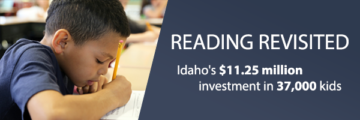In 1999, Idaho launched one IRI: the Idaho Reading Initiative. The state sought to give at-risk readers more time in the classroom, and give their teachers the added training they needed.
With that came Idaho’s “other” IRI — the Idaho Reading Indicator, a 15- to 20-minute test to identify at-risk readers.
With a new literacy initiative, Idaho wants to spend $11.25 million to give at-risk readers more time in the classroom, and give their teachers the added training they need. The old Idaho Reading Indicator remains intact, albeit somewhat changed from 1999.
Apparently, the test has run its course. The State Department of Education has received five bids from vendors that want the job of replacing the exam.
And that means the state could change its literacy metric — just as politicians, parents and educators try to gauge the results from the new reading initiative.
The IRI exam: Why it matters
The fall kindergarten IRI is particularly important, said Deb Glaser, a reading expert who helped design the original IRI, and now works as a consultant with the Boise School District.
Kindergartners are tested on letter recognition — weeks after walking into a school building, possibly for the first time. Teachers and principals learn which students have been read to, and which students have had practice writing.
The test evolves as kids age or change grades. In first grade, the focus is on letter sounds. In second and third grade, the focus is on reading fluency and reading speed.
The results give teachers and principals an important snapshot, identifying students who could be at risk of falling behind in reading. The numbers also paint a picture over time — showing student growth from fall to spring, and tracking a group of students from kindergarten through third grade.
On July 1, the IRI test results took on new value. They became the funding mechanism for Idaho’s $11.25 million literacy program.
Using three years of IRI results, the state calculates the average number of students who score below grade level. Dollars go out to school districts and charters based on this calculation.
What’s wrong with the IRI?
The IRI is a short screening test. Its mission is also its limitation.
Reading experts cite two main weaknesses in the current test.
First, the test doesn’t diagnose reading problems. It can tell teachers which students are struggling, but it doesn’t say why.
Second, the IRI doesn’t test reading comprehension — even in third grade, as students prepare to make the transition from learning to read to reading to learn. The IRI tests students on how many words they read per minute, said Karlynn Laraway, the State Department of Education’s director of assessment.
And that means problems can go undetected. Some students can read quickly, decoding words without comprehending their meaning. This is especially a problem for students with limited English skills, Glaser said.
Fluency and comprehension are connected. Students need to read at pace in order to begin to retain and comprehend material, said Becca Anderson, the Boise district’s language arts supervisor.
But as she works with kindergartners through fifth-graders, Dawn King worries less about pace, and more about command. The reading specialist at Boise’s Grace Jordan Elementary School believes the IRI needs to be changed, to add a comprehension component.
“If we’re going to measure reading, it can’t just be on speed,” she said.
Time for a change?

In 2017-18, state superintendent Sherri Ybarra wants the state to spend $5.9 million to revamp or replace the IRI. The promise of a lucrative testing contract drew five bids by the state’s Nov. 29 application deadline. The State Department of Education is starting to review the proposals, and hopes to have a new contract in place on July 1.
Department spokesman Jeff Church says it’s too early to predict what the finished product will look like. But it’s possible that the new exam will be so different from the existing IRI that there will be no way to draw apples-to-apples comparisons between the new scores and the historical results.
“That’s a fair question,” Church said.
For some legislators, it’s a serious question. As the state embarks on a multimillion dollar — and possibly multiyear — early reading initiative, they would like data that allows them to track the program and the return on their investment.
Rep. Wendy Horman has heard teachers’ concerns about the IRI, and says she tends to heed those concerns. But the Idaho Falls Republican — and an architect of Idaho’s K-12 budgets, as a member of the Joint Finance-Appropriations Committee — also sees the need for data. She also thinks the state’s data analysis has been lacking; knowing that changes in the IRI are looming, educators have been gunshy about drawing conclusions about Idaho’s at-risk readers.
But after helping develop the original IRI exam nearly two decades ago, Glaser believes this is a good time for a change. Idaho has already switched its standardized test — launching a new version of the Idaho Standards Achievement Test, aligned to Common Core standards — and can tailor its reading assessment to the new ISAT. Idaho can also tap into years of new research into reading instruction.
One constant remains. Idaho’s elementary school teachers need a test that will help them identify the students who need extra reading help, and risk falling further behind.
“The catchup game is not a very pleasant game to play, and kids don’t catch up,” Glaser said.
Literacy series, at a glance
Wednesday: Idaho schools try to bridge a wide reading gap
Wednesday: A close look at literacy dollars, and literacy demographics
Thursday: Literacy initiative tests political patience, and political will
Thursday: As Idaho revamps its literacy program, its reading test awaits a rewrite
Thursday: Rethinking literacy for special education students


